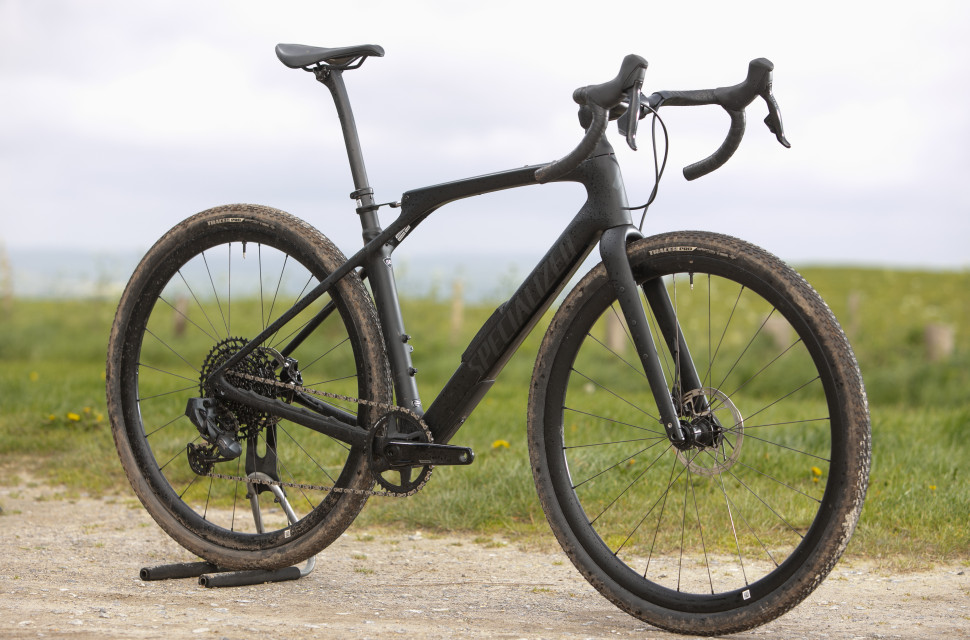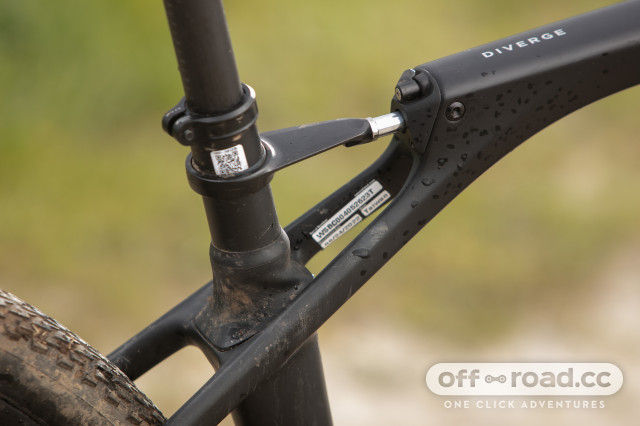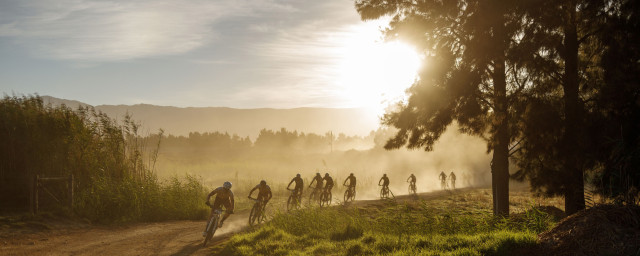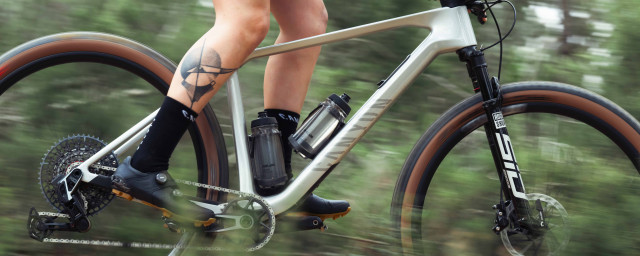I’ve been quite happy for my gravel riding to remain a suspension free pursuit; well, I was until I spent a couple of months on Specialized’s Diverge STR Expert. With the brand's Future Shock treatment now extending to the rear end of the Diverge, not only is it one of the comfiest gravel bikes on the market, but that ‘boing-free’ rear end also aids traction on climbs and minimises fatigue. Though, I'll admit, its aesthetics are quite divisive.
- Gravel racing - what's next for cycling's growing discipline
- Specialized Crux Comp gravel bike review
- Gravel bike suspension and dropper posts - do you need them?
Specialized Diverge STR Expert - Technical details
This STR frame design is only available in a few models, the Expert on test, the Pro and the S-Works version. The rest of the Diverge line-up gets the Future Shock front, but not the rear system.
The rear system can be adjusted to suit your riding style and weight. This can be fettled by changing what Specialized calls the Framepost, which is basically the sleeve that you’ll slide the seatpost into.
The Diverge is shipped with two of them (although we only received the one fitted into the frame of our demo model) with each frame size getting specific models. Depending on which post you use, and which direction you position it in changes the level of compliance on offer. I played around with the framepost fitted to ours and there was a noticeable difference in how the rear end of the bike felt. A flick through the Diverge's user manual shows clearly how to swap them over and adjust.
It'll take a little while to get everything set up how you like it but to be honest, it should be a fit-and-forget system that's only dialled in once. In total, you get four different options – two with each Framepost.
Rider weights of 44kg to 122kg are catered for over nine post options. If your size bike comes with posts that don’t quite suit you, you can purchase others separately.
The rear damper unit fits inside the top tube and is attached to the framepost by way of a tendon. Once all of the components are connected to each other you have the compliance (or stiffness) you require from the Framepost you can then tweak the level of compression damping in the system.
You have three options controlled by a small lever on the rear of the top tube which gives you fully open for the highest level of compliance, medium for a happy, er... Medium, and closed for a locked-out feel. There is a minimal amount of movement there though which can be noticed if you really focus.
The lever is easily reached while on the fly allowing you to toggle between the settings. From a hole under the top tube you can also adjust rebound damping too.
As a system, it can look quite complex, but it isn’t overly so, and from what I can see doesn’t require a huge amount of maintenance. Our bike came directly from another website so I’m not sure how many miles it had done prior to me riding it, but everything was working smoothly with no rattles or squeaks.
Up front, the Future Shock uses a damping system which is better in use than the original spring-loaded options. You can adjust compression by way of turning the dial that sits above the stem, but it feels very much like an on-or-off kind of setup. On the whole, it works well though and is a welcome addition to the STR.
The frame itself is made from Specialized’s own FACT 11r carbon fibre and it is finished well throughout. On the downtube, you’ll find a SWAT Door, an opening to allow you access to the inside of the downtube for storage in the provided bags. It’s a neat touch, swallows a good amount of kit, even stuff like a lightweight waterproof jacket and it also means that Spesh has to be on its A-game when it comes to the construction of the Diverge’s frame as it allows you to inspect inside.
Specialized has gone for a threaded bottom bracket set up to allay any creaking fears and all cables, hoses or wiring are routed internally.
The fork, as you’d expect for this kind of money is full carbon fibre and both it and the frame are running 12mm thru-axles and flat mounts for the disc calipers.
From a geometry point of view, there are six sizes in total with effective top tube lengths of 527mm through to 602mm. This 56cm has a top tube of 570mm, a seat tube of 500mm and a head tube height of 130mm which sounds short, but once you include the stack height of the Future Shock system comes in about right.
The wheelbase is 1,044mm overall, with 429mm chainstays, and the BB drop is 85mm. As for the angles, you are looking at 71.75 degrees for the head tube and 74 degrees for the seat tube. The fork rake is 55mm. All of this adds up to stack and reach figures of 609mm and 392mm respectively.
Specialized Diverge STR Expert - Componentry
For the drivetrain, we have a mixture of kit from Sram. The brake and shift levers are from the Rival eTap AXS range paired with a Rival 1x crankset wearing a 40T chainring while the rear mech, cassette and chain are all from the Eagle, mountain bike group.
The cassette is 12spd with a wide-ranging spread of between 11t and 50t sprockets, so I definitely didn’t find that I had to walk up any of the local climbs, and on the flat you have a gear to push against up to around 30mph depending on how high you like your cadence figure to be.
The hydraulic Rival calipers are punchy and progressive in extra measure, so you have plenty of stopping power when you need it and plenty of modulation and feel for when you don’t. the rotors are 160mm front and rear which is pretty much the norm for this kind of bike.
As for the rest of the kit, well that’s Specialized own brand kit but don’t feel as though you are being shortchanged as their stuff is well made with good ergonomics.
The handlebar is the Adventure Gear Hover, but there is no twin-level design as found on Canyon’s Hover bar, this one has a more traditional shape to it with 103mm of drop and 70mm reach. The drops also have a 12° flare which increases stability when riding in a lower part of the handlebar.
The stem is a standard alloy option although the seatpost is carbon fibre, nicked from Specialized’s top flite S-Works range and comes with a 20mm setback. The saddle is a Body Geometry Power Epert model which I found very comfortable due to its minimal padding and short-nosed design.
For this kind of money, you’d expect carbon fibre wheels and that is exactly what you get. Spesh’s own brand Roval Terra C rims in a 32mm depth and 25mm internal width. These are mated to DT Swiss 370 hubs (with the rear getting a ratchet freewheel) by 24 DT Swiss Comp Race spokes front and rear.
It’s a good set of wheels. Their weight doesn’t impact the ride quality and they seem robust enough to cope with all of the impacts and abuse found on my typical gravel rides.
The 42mm Tracer Pro 2BR tyres have a lightish tread so are better suited to dry and/or hardpack surfaces, but with the ability to run up to 47mm on 700c wheels, or 2.1” on 650b you won’t be short of options for different conditions.
If you stick with the Tracers though you’ll find them decent all-rounders and relatively supple which helps the overall ride feel of the bike.
Specialized Diverge STR Expert - Performance
As I said in the opener there, I was quite happy for full suspension to stay out of gravel riding and that probably comes from the fact that I came into it from a road background where the ride characteristics are firm, and a feeling of ‘squidge’ normally means that power is being wasted somewhere.
So, to sum that up – if a gravel bike is going to have any kind of suspension, I want it to do its job without letting me know it’s there at all, ignorance is bliss if you like.
I’ve ridden many Diverges over the years, from the early incarnations to the model before this one and they have definitely improved as time has gone on. In fact, I thought the 2021 Expert Carbon model was brilliant.
This new model has carried through all of the things that I liked about the previous version in that it is a lot of fun to ride. The front end has a well-defined balance of speed in the steering without ever going so far as to compromise stability, and even with the 20mm of travel allowed by the Future Shock system nestling under the stem, there is a huge amount of feedback passing through from the front tyre.
It’s the same at the rear end too. The Future Shock which replaces the junction between the seat and down tube allows for 30mm of travel which irons out the bumps being transmitted from the rear wheel without neutralising any of the info about what the rear tyre is up to.
In fact, once you have spent a bit of time getting the rear end dialled to your preferred riding style and bodyweight the Diverge feels just like a big tyred rigid gravel bike 95% of the time.
There is a small amount of bobbing about from the system when pedalling hard, but nothing major, and the rear end always feels tight from a ride point of view. The suspension does its job of minimising large bumps and to a degree high-frequency vibrations without detracting from the ride overall.
This of course means comfort, and lots of it. Even at speed, you get a sense of riding through imperfections rather than over them and this means you can stay in the saddle, and not get bounced off the saddle over sections that you normally would, which if you are out for a bit of an adventure makes a profound difference to fatigue levels.
Your position changes ever so slightly as the system moves, but I never really found it an issue. The benefits definitely outweigh any minor niggles anyway.
Due to the position of the rear system and the fact that it provides suspension to you when sitting in the saddle rather than the rear end of the bike as a whole, it doesn’t affect how the bike feels when you are out of the saddle. Hard efforts when standing still let you exploit the stiffness of the bottom bracket area and the tubes found lower down the frame, and if you don’t want any movement at the front, you can also lock out the Future Shock under the stem.
The rear can also be locked too, meaning that the Diverge STR doesn’t have a soggy feel on hardpacked surfaces or the road. In fact, it’s those surfaces that highlight just how racy the STR is. It has a certain nimbleness to it, and it flows nicely between through the corners.
This carries over well to loose surfaces. While that nimbleness makes it feel like a much lighter machine than it is, the stable nature of the handling allows you to slide the Diverge with a certain amount of control.
It responds very well to shifts in body position and a lot of my favourite times on the Diverge was when I found myself on some twisty, dusty singletrack sections in the woods. You can really let it all hang out, flicking the handlebar this way and that, or bunny-hopping your way out of trouble.
The front-end Future Shock takes the sting out of the roots and rocks, but it won’t work miracles which means you still need to use your elbows and knees as part of the ‘system’. The Diverge remains very much a rider’s bike still.
Overall, from a ride point of view for me Specialized has really delivered on the whole suspension idea from a gravel point of view. It works from a comfort and control point of view without any sacrifice in what I want from a bike, as in loads of feedback and a precise ride feel.
Specialized Diverge STR Expert - Value and verdict
This Diverge STR Expert costs £7,000 which is on the steep side for a bike with a mid-range electronic groupset and aluminium finishing kit in the majority of places. You are getting extra kit though like the front and rear Future Shock components and a frame design to accept it all.
Saying that though Trek’s Checkpoint SLR 6 AXS is £7,400 and comes with Rival AXS and deep-section Bontrager carbon wheels. It has 45mm available tyre clearance and uses Trek’s IsoSpeed decoupler system to soak up the bumps.
Canyon doesn’t rely on funky frame design for comfort on their Grail gravel bikes, instead using their split VCLS seatpost and that Hover bar to offer flex, both of which I find to offer great plushness.
If you can do without the damper systems of the Diverge then the Grail CF SLX 9 eTap is available for £6,200. It comes with a higher-spec Force AXS groupset and DT Swiss carbon wheels. It weighs around a kilogram less than the Diverge too.
The Future Shock systems work very well indeed on the Diverge STR, and for someone who started the review period very much against introducing full suspension to gravel bikes I was hugely impressed overall. When riding it is barely noticeable that it is there in terms of how it affects the ride and performance, it’s mostly when you have finished riding that you notice just how much of the bumps and vibration they have gotten rid of.
Away from the Future Shocks, the Diverge retains that great ride and performance of earlier models. I love the way it behaves and if you want a gravel bike that has a racy nature to it, and begs to flung down some twisty singletrack occasionally then it is worth putting on your short-list.

























Add comment